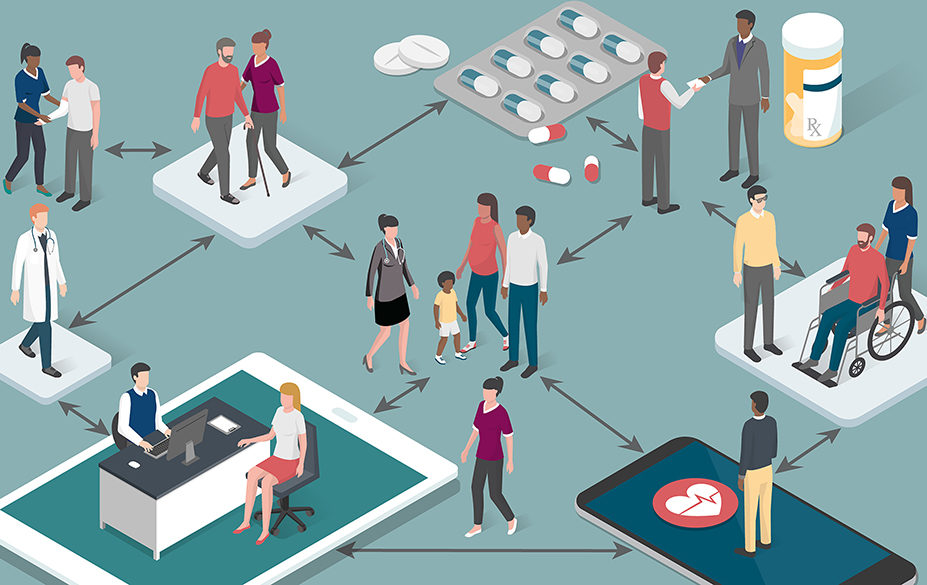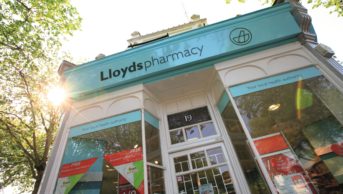
Mclean/Shutterstock.com
When Jim Harris* was discharged from hospital, staff were concerned that he would not be able to cope with his medicines at home and referred him to the medicines optimisation service within one of Croydon’s six Integrated Community Networks (ICNs).
Registered blind, Harris selected his tablets based on size but, increasingly, he was unable to do this reliably.
A home visit by the ICN pharmacist resulted in his medicines being rationalised and prompted a switch to using a multi-compartment compliance aid. During a follow-up visit, the pharmacist discovered that Harris had been sleeping on his sofa and living on takeaways for years. And while he travelled everywhere by bus, Harris frequently got on the wrong one.
On visits, we try to notice other issues to provide a more holistic view
Lucy Galloway
“On visits, we try to notice other issues to provide a more holistic view,” says Lucy Galloway, lead pharmacist for primary care, NHS South West London Clinical Commissioning Group (Croydon).
As a result of the pharmacist’s assessment, Harris’ case was added to the ICN’s fortnightly ‘huddle’, at which it could be discussed by the multidisciplinary team (MDT). Each ICN includes a network facilitator, GP, pharmacist, social worker, community nurse and personal independence coordinator (PIC) — a role provided by the charity Age UK. Complex cases are proactively managed; multiple agencies work together to develop care plans with the aim of keeping patients out of hospital. For Harris, this meant referrals to social services and the PIC.
Having the medicines optimisation service embedded within the ICN has allowed the pharmacy team to develop key relationships within the wider MDT, explains Galloway. It also enables a deeper understanding of local systems, their limitations and the consequences these have for patients.
Across England, health and social care providers and commissioners are working towards achieving this sort of joined-up care as part of an NHS masterplan to face down the looming demographic challenges of an elderly population and more complex disease, by caring for more people more effectively in the community. Central to this plan are integrated care systems (ICSs; see Box 1). The aim is for every part of England to be covered by an ICS by April 2021 (see Box 2).
Box 1: What are integrated care systems?
People are living longer and more are living with long-term conditions. This means that health and social care needs to evolve to become more integrated, allowing individualised treatment and helping to keep people out of hospital.
To address this need, different parts of the NHS — hospitals, family doctors, mental health teams and pharmacists — are working with local councils and care homes more closely than ever before to better coordinate services, spend more on keeping people healthy and out of hospital, and agree shared priorities for the future.
These integrated care systems (ICSs) grew out of sustainability and transformation partnerships (STPs) — local partnerships formed in 2016 to develop long-term plans for the future of health and care services. ICSs were a key element of the ‘NHS long-term plan’ and have been driven locally. They seek to remove barriers between health and council services, and to ensure residents get access to a wider range of services closer to where they live or work. Someone who regularly uses different services should be able to see just one team, with members who talk to each other and make time to understand their full care needs and wider health goals. Pharmacy and medicines optimisation are being integrated into STPs and ICSs through the Integrating NHS Pharmacy and Medicines Optimisation (IPMO) programme.
A new NHS white paper, published in February 2021, seeks to strip away unnecessary legislation and reduce bureaucracy, making it easier for health and care systems to work more closely. The white paper puts ICSs centre stage and sets out plans to give them legal status, taking on the functions of clinical commissioning groups (CCGs) and embedding a “duty to collaborate” between the NHS and local authorities.
Closer integration
Galloway sees the Croydon ICNs as a great example of closer integration. “Their development reflects a number of good things — such as stronger local partnerships and collaboration, as well as strategic commissioning,” she says.
Croydon’s ICNs were developed after an external review in 2017 showed the area had a higher than expected non-elective admission rate and poor integration of services compared with peer CCGs.
There are 50 GP practices in Croydon, with six pharmacists working across the six ICNs. Each pharmacist attends at least one huddle and will visit between two and four patients each day, sometimes with other members of the ICN. The ICN pharmacy service alone sees around 100 patients per month.
“In the past, although you’d have the coming together of the MDT, everyone would be working in silos outside the MDT,” Galloway explains. Within the ICNs, team members have trained each other to recognise when referrals are necessary. “We have upskilled each other so much that if we go in to [assess] medicines but we notice that the heating is broken or that the patient has not been upstairs for six months, we will then make a direct referral to social services or to the PIC,” says Galloway. “And, likewise, if social services go in to do a housing assessment or a care needs assessment and they see piles of medicines, which isn’t uncommon, they will trigger a referral to us straight away.”
The service is being moved to the next level with the development of ICN+, which began as a pilot in Croydon’s Thornton Heath area in July 2020. ICN+ involves the existing members of the ICN plus occupational therapists (OTs), physiotherapists and an integrated manager to manage both health and social care staff. “ICN+ is about strengthening those relationships,” says Galloway.
A similar model, albeit with different terminology, operates in Dorset, a county that NHS England has described as having “one of the most advanced [integrated care] systems”[1]. In Dorset, instead of ‘integrated community networks’ there are ‘integrated hubs’; ‘huddles’ are replaced by ‘virtual wards’ and ‘network facilitators’ become ‘health and social care coordinators’. However, the aims are the same: to proactively case manage patients who are at risk of hospital admission.
In the Purbeck area of Dorset, Dorset HealthCare University NHS Foundation Trust provides a pharmacist and pharmacy technician to the Integrate Primary Care service. An MDT (consisting of a GP, hospital consultant, social worker, community matron, pharmacist, pharmacy technician and therapists) meets twice per week to discuss patients brought to the virtual ward. Like Croydon, the patients are complex and can be referred to the team by any health or social care professional in the area.
By bringing that person up to the virtual ward, everyone can discuss that patient
Heather Pickford
“By bringing that person up to the virtual ward, everyone can discuss that patient,” explains Heather Pickford, Purbeck medicines management community pharmacy technician. “You’ve got the GP record open in front of you so you can see everything that’s going on; you can find out what input social services have had and put a plan in place to stop that person going into hospital.”
Box 2: Timeline to achieving integrated care
2014: NHS and local government’s national leaders set out a vision of more collaboration
2015: ‘Vanguards’ in 50 areas begin to develop and test new models of care
2016: NHS and local councils form partnerships covering all of England to consider local health and care priorities, and to plan services together
2017: Areas refine initial proposals, drawing on conversations with frontline staff, local residents and others in the community
2018: Some 11 partnerships begin to take on more responsibility by becoming ‘integrated care systems’ (ICSs)
2019: The ‘NHS long-term plan’ confirms that every area will be served by an ICS by 2021, with primary and community services funded to do more, and three more ICSs are announced.
2020: In May, a further four areas are designated as ICSs, bringing the total to 18 and, in December, a further 11 areas become designated as ICSs, taking the total to 29 and leaving 13 areas still working to achieve designation by the 1 April 2021 deadline
2021: Blueprint launched for NHS and social care reform; ICSs will have legal status, and the NHS and local authorities will have a duty to collaborate. The final 13 areas are designated ICSs from 1 April 2021.
Sources: NHS England, Department of Health and Social Care
Co-location, co-location, co-location
Sharing office space with the rest of the hub is vital to the success of the service, says Rob Harvey, lead pharmacist and advanced clinical practitioner, Dorset HealthCare University NHS Foundation Trust. “This close integration allows for a responsive, reactive service,” he says. Informal referrals are easier to make and inappropriate referrals can be avoided.
Galloway agrees: “When you go away from your huddle and you’re trying to sort out a patient, you can turn to your right and the nurse is there, and to your left and the social worker is there, and you haven’t got to send an email or make a phone call.”
Sonal Shah, the Thornton Heath ICN+ pharmacist, adds that co-location of staff means patients receive care in a more timely manner and have greater access to support services.
There is much more accountability for outcomes and it’s way more efficient than it was before
Lucy Galloway
“There is much more accountability for outcomes and it’s way more efficient than it was before,” Galloway adds.
Of course, the COVID-19 pandemic has had an impact on how the service is run, with MDT meetings currently being conducted virtually and risk assessments being strengthened to determine whether a home visit or phone consultation is the best approach.
A critical role within the Dorset hubs is the health and social care coordinator, who chairs the virtual ward meeting. “She is there documenting what’s been done and what needs to be done and, if necessary, she can action things herself,” says Pickford.
The health and social care coordinator also personifies the hub. “They are the hub really,” says Pickford. “Any emails, any requests to see patients in the community, it would all get directed to them and then they would ferry it all out to the necessary people.”
Key roles in Croydon’s ICNs are the PIC and integrated manager; both provide critical links between formal health and social care services and the wider community support networks. The PIC role also involves an element of befriending and supporting people with personal goals.
“As a pharmacist, I was so unaware of all of those things before we started this project,” says Galloway. “If patients brought up issues like [loneliness], your tendency was to try to bring it back to the medicines — but we don’t work like that in the ICN now. We work as a team, understanding everybody’s role.”
In Thornton Heath, the ICN+ integrated manager is Jennifer Daniel, a senior OT. “My role is to bring everyone together and to think collaboratively,” she says.
Shared records, shared learning
A potential barrier to seamless care is the use of different electronic patient record systems by different agencies. In Dorset, the GPs, pharmacists and therapists use SystmOne and are able to see each other’s notes, the mental health professionals use RiO and social services use a case management system called Mosaic. However, the hub’s health and social care coordinator has access to all of the systems. “You can always find the information [you need],” says Pickford. “It’s about … knowing who to go to or who to ask to get to that person.”
In Croydon, a system called Coordinate My Care gives “limited, but nonetheless beneficial” access to shared records, explains Galloway. “We still don’t have sharing between the council and health but because [the team is located] in the same office, we’ve broken down that barrier.”
Both Dorset and Croydon encourage shared learning among their MDTs. Before the COVID-19 pandemic, the Purbeck team ran lunchtime training sessions. For example, the physiotherapist offered general training in falls assessment. And in Croydon, the OTs provide training on basic OT assessments so that any member of the ICN team can assess patients opportunistically.
A better awareness of the roles of others means that I can identify patient needs and refer on rather than working in a silo
Sonal Shah
“A better awareness of the roles of others means that I can identify patient needs and refer on rather than working in a silo,” says Shah, who along with other members of the ICN+ team has been trained to do basic observations, such as taking blood pressure, and checking breathing and temperature. Pharmacists are also being trained to administer vaccines, allowing them to vaccinate opportunistically.
“It’s about making every contact count,” says Galloway.
The pharmacists on the teams are also training others to recognise medicines-related problems. Some of the ‘red flags’ that would trigger a referral to the ICN’s medicines optimisation team include stockpiles of medicines, expired medicines, multiple dispensing dates and medicines running out before others.
“It’s early days,” says Galloway, “but in the first two months following the roll out [of ICN+], we saw a 20% increase in the number of referrals to the ICN+ pharmacist”.
Impact on admissions
The implementation of ICNs in Croydon coincided with a 12% decrease in non-elective admission rates in the first year of the service (April to August 2018 compared with April to August 2017)[2]. The most recent data suggest that between April 2019 and March 2020, 1,156 hospital admissions were avoided (although this is an estimate obtained by asking the question “Do we think we have avoided an admission?” to the MDT at the point of discharge from the huddle).
In the early days of Dorset’s integrated hubs, NHS England highlighted a reduction in acute hospital admissions[1]. But up-to-date figures are lacking, with much of the routine data monitoring on hold because of the COVID-19 pandemic.
There are some signs, however, that this type of intense management of complex cases can have the opposite effect and lead to an increase in hospital admissions.
Researchers from the Improvement Analytics Unit (IAU), a partnership between NHS England, NHS Improvement and the Health Foundation, examined the impact of integrated care teams in the Fylde Coast area of England (an area served by NHS Blackpool CCG and NHS Fylde & Wyre CCG). They found increased use of emergency hospital services among patients managed by the integrated care teams compared with matched controls[3]. The researchers offer several explanations for their findings, including that MDTs may identify unmet medical need and that the benefits of integrated care are likely to take several years to have an effect.
Therese Lloyd, a senior statistician at the IAU, says hospital use may not be the best measure of the benefits of MDTs[4]. Their value may lie, instead, in improving patients’ experience of care or quality of life, she says. However, these factors are difficult to evaluate because they are not routinely recorded.
Evidence shows that success is highly dependent on local context and relationships, and results often take years to materialise
Helen McKenna
Helen McKenna, senior fellow at think tank The King’s Fund, says expectations about what integrated care can achieve in the short term should be tempered with realism. “Evidence shows that success is highly dependent on local context and relationships, and results often take years to materialise,” she says. “It is therefore not realistic to expect integration to lead to reductions in demand for hospital services or financial savings, at least in the short term. And it is worth remembering that the goal of integration is improved outcomes, not necessarily reduced demand or cost savings.”
In Croydon, Jim Harris has enjoyed some immediate benefits of integrated care. He has a new cooker and sleeps upstairs in his new bed. And a taxi card is helping him to attend social events and make connections with others in his local area.
Despite the lack of hard evidence for the positive impact of integrated care on hospital admissions, Galloway is confident that she is making a difference: “You can fix the medicines all you like, but if you haven’t fixed the other things, then it doesn’t work — the patient is still at risk of admission or deterioration.”
*not patient’s real name
This article was amended on 22 March 2021 to add additional information.
- 1NHS England. Older people living with frailty on ‘virtual ward’ keeps them well at home and out of hospital. Integrated care case study. . NHS England. https://www.england.nhs.uk/integratedcare/case-studies/older-people-living-with-frailty-on-virtual-ward-keeps-them-well-at-home-and-out-of-hospital/ (accessed Mar 2021).
- 2Croydon Clinical Commissioning Group. Croydon integrated community network medicines optimisation service. NICE Shared Learning Database. https://www.nice.org.uk/sharedlearning/croydon-integrated-community-network-medicines-optimisation-service (accessed Mar 2021).
- 3Vestesson E, Shen J, Pariza P, et al. The impact of Extensive Care Service and Enhanced Primary Care in Fylde Coast. The Health Foundation 2020. doi:10.37829/hf-2020-da19
- 4Lloyd T. Are multidisciplinary teams an effective tool to reduce emergency hospital activity? The Health Foundation. https://www.health.org.uk/news-and-comment/blogs/are-multidisciplinary-teams-an-effective-tool-to-reduce-emergency-hospital (accessed Mar 2021).

